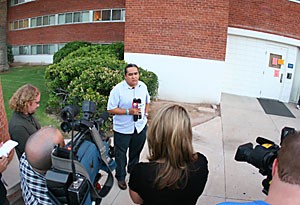A Navajo man led a sacred ceremony last night in the lobby of Graham-Greenlee Residence Hall to help purify the building following the violent death Wednesday of Mia Henderson, a biology freshman and member of the Navajo Nation.
The Navajo prayer, cleansing and healing ceremony was led by Thomas Yazzie, a well known traditional Navajo medicine man, said Manley Begay, a UA professor of education and American Indian studies and director of the Native Nations Institute for Leadership, Management and Policy.
“”The aim is to restore harmony,”” Manley said. “”It’s a given that a tragedy has occurred in one of the buildings here, and the ceremony is a way to begin to heal the tragedy that has occurred.””
Between 50-60 native and non-native residents of the Graham-Greenlee dorm and members of the UA faculty participated in the event that included rituals involving prayer, fire and water, Begay said.
No cameras, ipods or recording devices were permitted inside. Access was provided only to Graham-Greenlee residents and UA faculty, he added.
Others were not allowed within the perimeter of the sidewalk surrounding the building and UAPD was on hand to ensure that the ceremony was not disturbed.
While it was scheduled to begin at 6:30 p.m., Yazzie elected to wait until 8 p.m., well after sundown, for spiritual reasons, Begay said.
“”The cleansing and the restoration of harmony really is about exactly that; it’s about getting people back in to the correct fame of mind,”” Begay said. “”It’s also about a cleansing of the building.””
In the Navajo sense of the world these buildings are alive, he said. “”They’re not just sort of bricks and mortar; they’re actually living entities.””
Because the Tucson valley is considered Tohono O’odham land, the Navajo people had to ask permission to conduct the ceremony.
“”It’s always important to acknowledge whose traditional territory you are on – out of respect, said Begay, who is a member of the Navajo Nation.
Lisa Edd, an interdisciplinary studies senior and a member of the Navajo Nation, said that the purification ceremony is a common Navajo practice that accompanies a death, especially one precipitated by violence.
“”The purification ceremony will help students who can’t sleep in case there was some kind of connection with (Henderson),”” Edd said. “”It helps guide her spirit in the right direction, so that it’s not left to linger around the dorm and haunt the other students.””
The common mourning period is four days, she added, during which mourners are asked to be mindful of their actions and respectful of the deceased.
Both Henderson and her alleged killer, Galareka Harrison, a public administration freshman, were students in the UA First-Year Scholars Program aimed at promoting retention rates of American Indian students.
In the past 10 years, the program has helped to boost the persistence rate of Native American students by 9 percent, from 60 to 69 percent.
According to statistics from the Native American Student Affairs Web site, American Indian students currently make up about 2.2 percent of the student body.
When asked about the Navajo vision of the afterlife, Begay said actions in this life have consequences that follow after death.
“”There are other worlds beyond this world, and it also behooves all of us to live very carefully in this world that we’re at now,”” he said. “”If you don’t live very well in this world, there are consequences elsewhere.””









